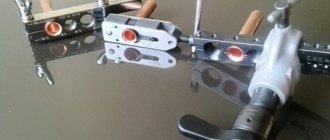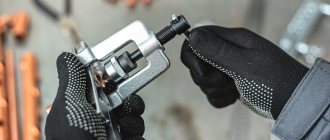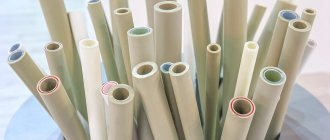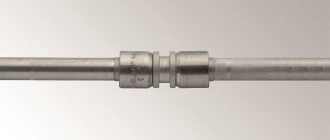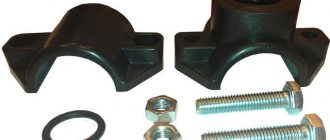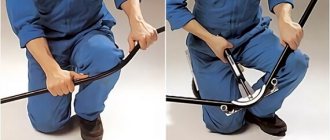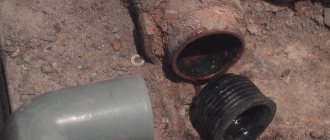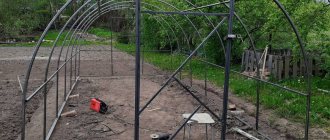Tool
When rolling with your own hands, you will definitely need special tools such as units for bending steel sheets or sheet bending rollers. The listed tools are easy to use, versatile and highly accurate.
Ticks
There are many tools available for rolling. They differ in application features:
- T series tools are used for working with small diameter pipes (6-11 mm). The equipment allows you to set the rolling depth;
- ST series tools are used to work with elements whose internal diameter is 6-11 mm behind the weld seam;
- RT series tools are used to work with products with small diameter (5.50 – 11.5 mm);
- P series tools are used to work with products with large diameters (12-40 mm);
- CP series tools are used to work with products that are a structural element of thick pipe grids;
The 5P series tool is used to work with thin-walled pipes with large diameters made of stainless steel or titanium alloys.
How is rolling done?
Do-it-yourself rolling comes in several types. Work can be done with a cone, without an eccentric and ratchet, with an eccentric
When bending, it is very important to follow safety rules
The general meaning of the work being performed is to transfer the cold state to the ends of the pipes in the holes of the same structures. This method allows you to reliably connect all the elements and ensure the strength of the structure. So, let’s look at the stages of rolling with our own hands (photos will allow us to more clearly imagine this complex work):
- The part is installed in the hole intended for this purpose. In this case, a hole is usually formed between the walls of the product and the walls of the unit. Normally it should not exceed 1 mm;
- The part is being expanded. As a result, the gap should disappear. The part is firmly fixed in the hole;
- The outer surface, expanding, begins to exert pressure on the pipe drum, resulting in its deformation. Upon completion of the work, the pipe drum will again take its previous shape, which will create the necessary compression. This factor makes the connection so reliable.
This operating technology is suitable for both large-diameter pipes and small-diameter pipes
It is very important to choose the right tool for rolling. Otherwise, excessive deformation of the drum metal may occur, which will lead to increased expansion and rupture of the part.
In order for rolling with your own hands to be done correctly, you need to know the specifics of the work of the tools used, be able to use them correctly, and study the technology of metal bending
It is important to study the relevant instructions and know the specifics of working with a particular metal. In order to perform pipe rolling efficiently, we recommend watching the corresponding videos and photos that show the work of professionals.
So you can see with your own eyes how to correctly deform metal sheets
It is important to remember that when rolling it is necessary to follow not only the instructions for the correct work, but also safety rules.
How to flare a copper tube at home
When installing copper piping systems, it is often necessary to expand the cut end of the pipe - for installing climate control systems or soldering heating and water supply pipelines.
I greet our dear reader and offer an article about what flaring of copper tubes is, in what situations it is used and how to do it yourself.
What is it and why is flaring necessary?
Flaring is a radial uniform expansion of the walls of a copper pipe. When flaring, a conical expansion of only the end of the pipe or expansion of a sufficiently long section can be carried out, in which a sleeve is formed - a section of a larger diameter.
The need for such deformation at home arises:
- When installing air conditioning systems.
- When repairing refrigerators, heat exchangers, cars, household appliances, heat pumps.
- When installing heating and water supply systems.
When installing using welding (soldering), the ends of copper pipes are flared in the form of a coupling, inserted into a pipe of the original diameter and welded. Flaring is used less frequently than soldering with fittings, as this method is slightly less reliable, but sometimes fittings may be in short supply or not available for repair work.
The need for flaring arises if the necessary fittings are not at hand, it is not possible to purchase a copper tube of the required diameter, or a very precise adjustment of the size of the tube along the internal section is required. In practice, flaring is used when installing climate control equipment, in cars, and during urgent repair work, when copper tubes available on the farm are used.
Flaring stages
To obtain a high-quality cone or expansion coupling at the end of a pipe, it is necessary to follow the correct work procedure.
Flaring as a process of deformation of the ends of copper pipes includes the following steps:
- Cut off the pipe blank. Copper is a very soft material, so it is necessary to use a quality pipe cutter designed for soft pipes made of non-ferrous metals.
- After cutting even with a high-quality pipe cutter, the copper pipe becomes jammed and its internal diameter decreases. Therefore, with the help of a special device - a rimmer - a chamfer is removed from the inside of the workpiece, and the shape is restored.
- Clean the end of the tube from burrs, remove copper shavings, dust, dirt, and grease.
- The workpiece is inserted into the flaring machine and rotated until a small socket is obtained with a wall angle of 45° to the pipe axis.
- Take out the product, try it on to see if it is the right size for further installation with a union nut. If the diameter of the socket is insufficient, then the flaring operation is repeated. An insufficient socket during installation creates an unreliable connection: water leakage is unpleasant, refrigerant leakage is dangerous, since it consists of toxic fluorocarbons.
- Then the pipe is used for its intended purpose.
All the details of flaring a copper tube can be seen in the video.
Tools and accessories for rolling
For high-quality expansion of pipe ends, a special tool is used - mechanical or electrically driven. The use of cones or templates and manual expansion are used only for manual rolling of single pipes. If you have to install a heating system or plumbing, it makes sense to purchase a mechanical flaring machine.
Expander
An expander is a simple rolling machine with several template attachments for processing pipes of different sizes.
It stretches the ends of the tubes quite quickly, the force is applied using a lever, and flaring does not require much physical effort.
The quality of flared products is not ideal - most likely, the deformation will be non-uniform, thinner sections of the walls will stretch, and the bell will have different thicknesses. Cracks and tears may occur.
Cone flaring machine
The cone tool is one of the simplest, providing an acceptable quality copper flare, but worse than other types of mechanical flaring tools.
The pipe is fixed in a vice, the cone is pressed into the workpiece several times, each time to a greater depth, then removed - and so on until a bell of the required size is obtained.
This device is used quite often because of its cheapness and simplicity.
Mechanical flaring machine
The best quality of rolling is ensured by a flaring machine in which the pipe is processed using several rollers made of alloyed tool steels. The tool is equipped with a set of rollers for several pipe diameters.
The essence of the process
Radial deformation or flaring of copper pipes in the hole of a special apparatus is necessary to create a strong adhesion of structural elements, for example, a pipe with a tube sheet. In this way, parts are secured in condensers, boilers, oil coolers, steam generators and other heat exchangers.
Stages of pipe flaring
Manipulations are carried out in three stages:
- The required gap between the part and the tube sheet is selected.
- Both elements are deformed.
- The pressure (load) is removed from the outer surface of the deformed workpiece.
During the process of flaring copper tubes, the metal softens, stretches (goes into a state of plastic deformation), and the tube sheet material goes into a state of elastic deformation. For the manipulation to be successful, the grating material must be harder than copper.
At the end of the flaring process, the grid “encircles” the pipe section. We obtain a press connection, the strength of which is ensured by the contact pressure of the surface of the part and the grid hole.
Sometimes welding is used to connect these elements - this type of fastening is called combined. When installing a copper water supply, one of the parts is expanded, then a second pipe is inserted into it, after which the gap between them is filled with solder.
It may be necessary to change the diameter of parts in the following cases:
- If a stamped (cast) product of the required shape cannot be purchased ready-made (it is not produced or is out of stock).
- A delicate adjustment of the bending angle, the size of the tube or its internal diameter is required.
Ways to increase pipe diameter
The tool used to carry out the manipulation is called a copper tube roller. In industry, high-strength shafts are used, which are rolled several times, resulting in a profile of the desired configuration. Work can be performed on special machines and machines, bending rollers.
Copper is a ductile material, so if you have dexterity and great physical strength, you can manually try to pull a copper blank onto a conical template (blank) to get the desired connection. They resort to this homemade method, which does not use rolling for copper pipes, in extreme cases, since the result is difficult to predict. There may be ruptures in places that bear the maximum tensile load; a thin part may simply become wrinkled and become unusable due to uneven thinning of the pipe walls.
The second option is intermediate between full processing of workpieces and stretching parts by force - using an expander. The device has several replaceable nozzles that allow you to use a lever to stretch the pipe to the desired diameter in one go.
Important. An expander is good when you need to do work quickly, but the results of such expansion also do not guarantee one hundred percent success. If the walls of the tube were not ideal initially (they had differences in thickness in different areas of the surface), thinner zones will stretch more, while thicker areas will not change shape. And if you try to “press”, just as in the previous case, ruptures and breakage of the part are possible.
A proper copper pipe flaring machine consists of a roller or several rollers made of carbide materials that are rolled over the inner surfaces of the pipe many times. During the flaring process, the pressure increases with each revolution - the workpiece is deformed in the desired direction gradually and smoothly, which eliminates the possibility of ruptures. In each approach, the rollers change the internal diameter of the workpiece to a minimum value; the metal easily tolerates such gradual stretching.
In this case, the wall thickness changes evenly; denser sections of the pipe with different wall thicknesses are rolled out to the same thickness as the thinner ones. And the surface becomes perfectly smooth, without roughness. Just as under the weight of a tram, which passes over and over again on the rails, the latter become smooth and shiny, the surface of the part under the influence of the shafts will be uniform.
You can also flare the segment using a cone. The principle of operation is simple - the cone is pressed into a pipe pre-fixed in a vice to the required depth, then removed. The quality of the result is inferior to working with shafts, but cones are also used quite often.
How to flare a copper tube at home Metalworker's Guide
Adjusting the diameters of pipes when connecting them is not an easy task. Either there is no workpiece of the required size, or the wall thickness in different parts of the part differs.
But the need to work with product diameters arises not only in industry; expansion of structures for hermetically sealed fastening of household communications is also often required.
Let's find out what do-it-yourself flaring of copper tubes is, why it is carried out and how to proceed to get a good result.
How to flare a copper pipe with your own hands
When connecting copper pipes to each other or when joining them with working parts, for example, air conditioners, special preparation of their ends is required - the so-called flaring. The durability of the future system directly depends on how well it is made, because the vast majority of problems with refrigerant (freon) leakage from air conditioners are associated with poor-quality joints.
Most often, flaring of a copper pipe is required when installing an air conditioner yourself
Our article will discuss how to properly flare a copper pipe.
The essence of the process
Pipes in heat generating and heat exchange units usually have a small diameter. Therefore, when butt welding such pipes, the burr formed inside significantly reduces the throughput of the unit, disrupting the performance of the pipeline.
The use of shaped elements inserted into the pipes being connected leads to the same result - the internal cross-section is reduced.
If, before connecting, the end of the pipe is widened and then put on another pipe, fitting or pipe of the connected device, loss of throughput can be avoided.
Note! Flaring, beading or beading is the expansion of one or both ends of the pipe and changing the shape of the edge. This forming makes it possible to make a socket of the desired shape at the end of a straight copper tube, which is necessary for connecting it with other structural elements.
The essence of the process is that a thin layer of metal softens under mechanical load and gradually takes on the desired shape. This increases the surface area and reduces the wall thickness of the pipe edge.
You can roll a pipe from any material, but in most cases it is technically difficult and does not justify the labor costs, since you can always buy either ready-made socket products or the necessary connecting elements.
At home, it is mainly copper tubes that are flared, which are relatively easy to deform due to the softness and elasticity of copper.
Functions of brake pipes
Brake pipes are an integral element of the braking system of any car, which is responsible for stopping it at the right time. To understand the importance of such pipes for the operation of the brake system as a whole, you should at least superficially become familiar with the principle of its operation.
So, the process of stopping a car, for which the brake system is activated, consists of the following stages.
- If necessary, reduce the speed of the vehicle or stop it completely, the driver presses the brake pedal.
- The master cylinder piston connected to the pedal is activated and begins to act on the brake fluid.
- Under high pressure imparted by the master cylinder piston, fluid begins to flow through tubes and hoses into the cylinders of each wheel, affecting their pistons.
- Under fluid pressure, the pistons act on the brake pads, which are pressed against the brake discs, stopping the wheels from rotating.
Car brake system diagram
Obviously, brake pipes play a vital role in the operation of the entire braking system, and if they break, it completely fails. That is why the repair of these elements, which includes and, should be approached with all responsibility.
How to perform flaring
So, after preparation, they proceed directly to flaring:
- If necessary, put a return nut on the pipe in advance, so that later there will be no incident with the fastening of the pipe, since it will no longer be possible to put it on the flared end.
- The prepared pipe is clamped in the die, having previously selected a hole of a suitable diameter in it. It is necessary to clamp so that the end of the pipe protrudes slightly above the surface of the die, and the pipe itself is securely fixed. The height of the protrusion depends on the diameter of the pipe and is selected according to the table below.
| Tube diameter | Height (mm) | Bead diameter (mm) | |
| (mm) | (inches) | ||
| 6,35 | 1/4 | 1,0…1,3 | 8,3…8,7 |
| 9,52 | 3/8 | 0,8…1,0 | 12,0…12,4 |
| 12,70 | 1/2 | 0,5…0,8 | 15,4…15,8 |
| 15,88 | 5/8 | 0,5…0,8 | 18,6…19,0 |
| 19,05 | 3/4 | 0,1…0,5 | 22,9…23,3 |
- Next, move the rolling element to the desired hole and clamp it. Usually there are special marks on the die for proper fixation of the rolling element. When properly fixed, the top of the cone will coincide with the center of the pipe hole.
- Rotate the screw of the rolling element. In this case, the cone gradually enters the pipe, expanding its end. Rotation is carried out until it stops.
- Unscrew the screw back, release the pipe from the die, and check the result. The output should be an evenly flared symmetrical end without displacement to the side and without bevel. In addition, there should be no cracks, breaks or other damage. If something like this occurs, the failed area is cut off and the procedure is repeated.
When flaring a copper pipe, the mistakes shown in the picture are not allowed.
Take the quality of the flared pipe seriously as it is important for the proper functioning of the system in the future. A job well done will prevent unwanted agent leaks and equipment breakdowns.
- The flared area is processed again - burrs, possible chamfers and irregularities are removed. Here it is necessary to achieve a perfectly flat and smooth surface in order to further achieve complete tightness of the joint.
You can clearly see the rules for flaring from the video below.
If you did everything correctly, then the flared pipe can be considered completely ready for further installation.
Thus, we described the stages of preparing a pipe for flaring, told which one is better and how to use an expander for a copper pipe, and provided instructions for doing flaring yourself.
Flaring technology and stages
Copper tubes are connected to each other or to other elements of the pipe structure by welding or coupling.
Depending on the connection method (fitting or welded), the technology for preliminary preparation of the pipe edge differs.
- To complete the welded assembly, the end of the pipe is expanded - the hole is expanded until its internal diameter becomes 0.1-0.2 mm larger than the external diameter of the attached part. The gap between the elements to be connected will be filled with solder during the soldering process, which will ensure the strength and tightness of the assembly.
- To make a fitting connection between parts, the hole in the copper tube is not simply expanded to the required size, but a chamfer of the desired shape is prepared at the end, usually at an angle of 45⁰. This increases the contact area, thereby ensuring the reliability of the unit. The natural plasticity of copper also helps with this - when the joint is compressed with a fitting, the softened metal tightly grips the part attached to the pipe and fills all the gaps.
Preparatory work
How to properly prepare a pipe end
Before you start flaring directly, you need to prepare. Preparation begins at the pipe cutting stage, namely, ensuring that after cutting the end of the pipe meets the following conditions:
- had no bevels (must be made strictly at 90 degrees relative to the axis of the pipe);
- was smooth;
- did not have a collapse of the edges.
When cutting a copper pipe, the mistakes shown in the picture are not allowed.
To do this, cutting is carried out according to the instructions below:
- A special pipe cutter for copper pipes is put on and secured to the section of the pipe where the cut mark was previously applied.
- Slowly cut through the pipe in a counterclockwise rotational motion.
- Check the end for any irregularities or bevels.
- Using a file and/or sandpaper, remove possible irregularities and burrs from the end.
Flaring tool
You will also need a flaring machine to complete the task. This is a special die with template holes for different pipe diameters, to which a rolling with a cone is attached. This tool can be purchased at a specialty store. As a rule, it is sold complete with a pipe cutter and devices for processing pipe ends.
This is what a tool for flaring copper pipes looks like
When choosing an expander for copper pipes, make sure that the die has a hole for the diameter you need. In addition, the kit should include an example in the form of a piece of pipe with a flared end, made with this particular tool.
Recommendations for flaring
Independent beading of copper tubes is an easy task only if you have practical experience. At the same time, the tightness and reliability of the connections made depend on the quality of flaring.
Therefore, before installing a copper pipeline, installing or repairing heat-generating devices, it is better to practice on pipes of different diameters.
Note! When choosing a tool for flaring, you should evaluate its necessity and rationality of purchase.
A specialist professionally involved in the repair of pipelines or equipment will need a set of professional tools, which, in addition to a flaring tool, includes a pipe edger, a pipe bender and a pipe cutter. For rare repair work, an inexpensive flaring tool with a minimum set of attachments will suffice.
Recommendations to help you perform flaring correctly:
- Before starting work, carefully check the pipe: there should be no burrs or debris on it, the edge and walls should be smooth and free of bends, only pipes with a round cross-section are allowed for flaring.
- During flaring, it is important to ensure that the expanding tip does not skew relative to the pipe. Otherwise, the socket will be asymmetrical and will not be able to provide a reliable connection.
- When expanding a pipe manually, the taper blank should be screwed in rather than pressed into the hole. This will help distribute the force and avoid damaging the pipe.
- It is better to carry out beading of a pipe with an expander in two or three stages. First, widen the edge a little, and then turn the expander and stretch the pipe to the desired diameter.
- When installing a pipe into the die of a rolling machine, you should select the hole that exactly matches the diameter of the pipe.
- Before flaring, the outer surface of the tube is treated with an abrasive sponge to remove dust and debris and ensure reliable fixation in the holder. If this is not done, the tube will slip in the die, interfering with the flaring process.
